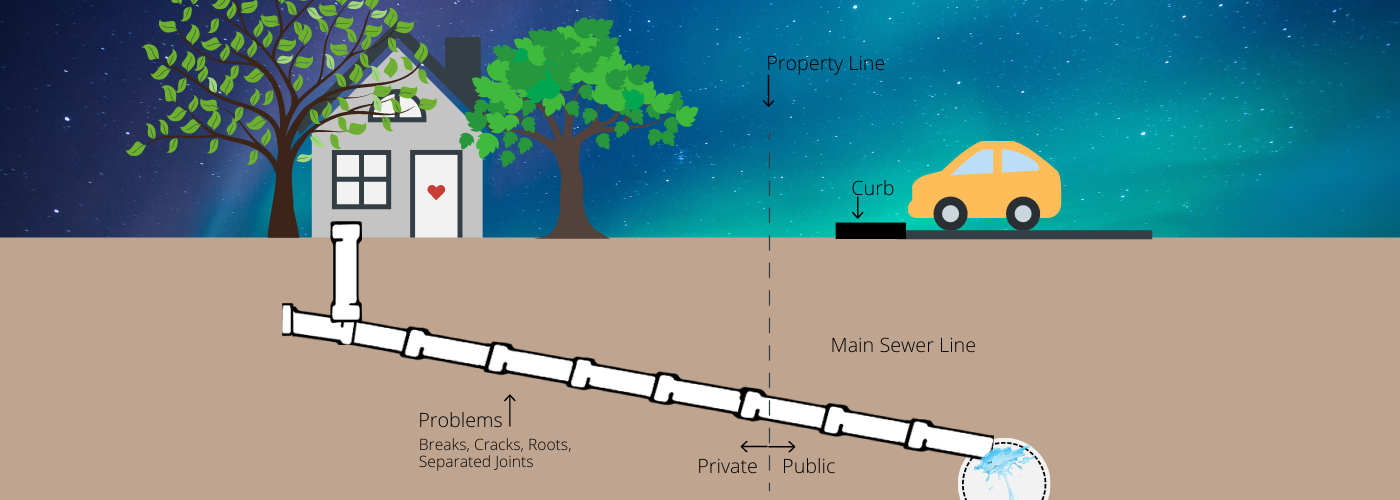Sewer Service Back-up
If you are experiencing a sanitary sewer problem, you may need to involve the City. In all cases, you must first contact a plumbing contractor. They will diagnose the issue you are experiencing. In many cases, cleaning out the line will clear the obstruction.
Steps to Follow:
| Step 1: Contact Plumbing Contractor |
|
In most cases, a plumber will diagnose and correct the problem you are experiencing. They will compile their observations on an invoice. If the issue cannot be corrected by a plumber, you will need to contact the City for an assessment of the issue. |
| Step 2: Contact the City |
|
In some cases, we will reimburse or cover the costs of the repair or replacement. See below for details on the costs the City will cover. Video footage is required in the proper submission of documentation. In order to be considered, you must submit a Release of Claim form and supporting documentation (invoice and plumber notes MUST be included). Email us the completed documentation. |
| Step 3: Internal Review |
| An internal review will be completed by the Utility Manager in consultation with the Water and Sewer and Parks Manager. The review process includes an assessment of the plumber notes and a site visit. Cameraing (Video footage) of the line is now required as part of the investigation to help determine the cause and precise location of the problem and complete the reimbursement process. |
| Step 4: Reporting Findings |
|
The results of the internal review will be shared with the property owner including identification of the failure, options available to fix the issue, costs and cost sharing/reimbursement options. |
Fixing the Issue:
There are a few options available to fix a sewer disruption.
| Cleaning and Maintenance |
| In many cases, cleaning out the line will clear the obstruction. You will need to contact a plumber who will diagnose and correct the issue if possible. Regular cleaning of sewer lines is recommended by all property owners to ensure the integrity of sewer lines over time. |
| Relining |
| Sewer lines that are in poor condition may benefit from relining. Relining is a process that restores the sewer line to a like-new condition. Relining is where material is inserted into the line, expanded to take shape of the pipe and steamed to solidify it. This is preventative option that can be used before a line collapses and requires a costly and disruptive dig to replace. |
| Replacement |
| Sewer line replacement is required when a portion of the pipe collapses. Whenever possible it is beneficial to restore the line through relining before a collapse occurs. Relining is a cheaper, less disruptive option. |
Re-imbursement:
Utility services are a shared responsibility of the City and property owners. As a property owner you are responsible for the portion of the services connected on your property. We are responsible for the portion on the City’s owned side.
|
Connection Failures |
| If there is a failure, the cost for the investigation, maintenance, repair or replacement covered by the City depends on where the failure occurs. Cameraing (Video footage) of the line is now required as part of the investigation to help determine the cause and precise location of the problem and complete the reimbursement process.
City-owned portion = 100% reimbursement These costs can include plumber bills, cameraing of the line, relining or digs to replace or repair the pipe. |
| Boulevard Trees |
|
Tree removal is a last resort and only done if a dig is required or the tree has deteriorated. Root intrusions are an indication that a sewer pipe is nearing the end of its lifespan. Tree roots are not the cause of a failure as a pipe with good integrity does not allow roots to penetrate. Cameraing (Video footage) of the line is now required as part of the investigation to help determine the cause and precise location of the problem and complete the reimbursement process.
|
Types of Sanitary Sewer Failure:
| Blocked Line |
|
Blocked drains can be caused by flushing or draining many common household items into the system. Items like diapers, baby wipes, sanitary napkins, kitchen grease, combs, hair, plastic materials, oil, sump pump water or newspaper rags and cloths can all cause a blocked line.
|
| Junction or joint collapse |
| Junction or joint collapse occurs when a section falls into the pipe. This will create major problems in the main sewer line as well as the house connection. |
|
Tree Root Intrusion |
| Tree interference into your sewer systems is a huge problem and can be extremely costly, as ongoing work may be required to keep the roots in check. In Prince Albert, root intrusion into service connections are the cause of the majority of all sewer blockages and is likely to occur in older systems and cracked pipes. |
| Collapsed main line |
|
A collapsed main line is not an uncommon problem – it can happen for several reasons. It may also cause significant ground contamination and pollution of the surrounding waterways. |
| Connection Fractures |
| It is recommended to replace or repair the pipe as soon as you detect fractures to avoid pipe collapse or leaks. Fractures can lead to a service collapse, increasing the cost of repair and inconvenience significantly for the homeowner or business. |
| Offset joints or connection |
| Offset joints or connections can occur due to ground settlement, landslide, tree roots, and poor compaction during installation. This can cause damage and weakness to the main line and potentially generate massive leaks. |




